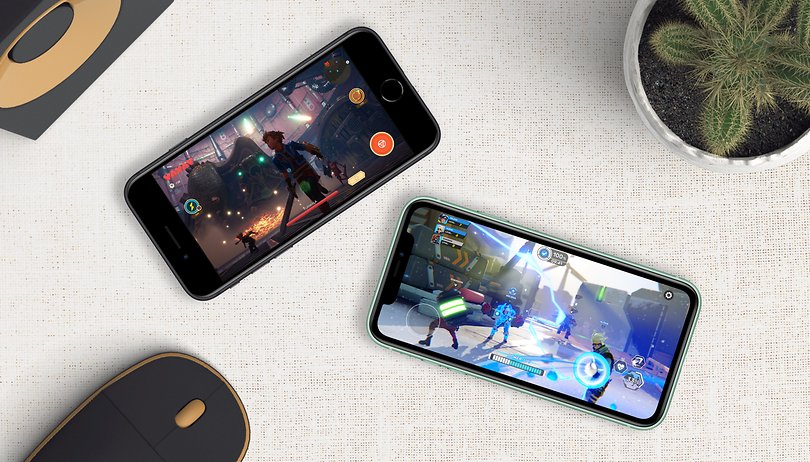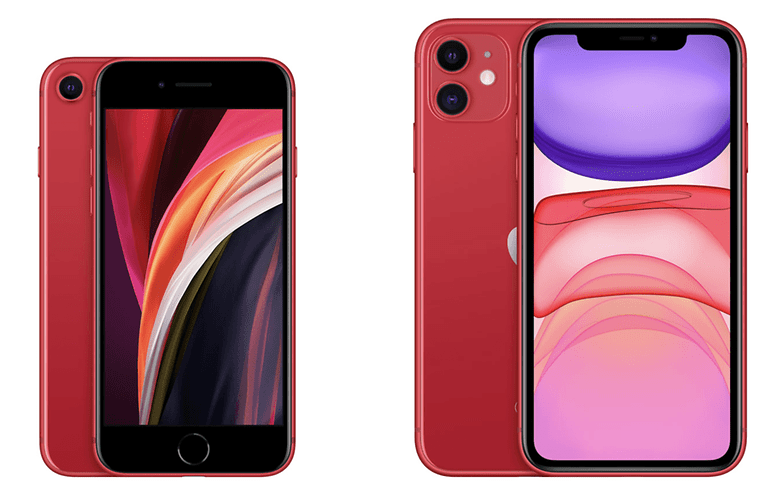The iPhone SE offers plenty of bang for your buck

Apple has learned its lesson from the iPhone XR faux pas, and decided to release an all-new iPhone SE. There was plenty of buzz online for the second-generation iPhone SE as it was considered to be a flagship killer which could help prop up Apple's bottomline for 2020, and then some, despite the worldwide coronavirus pandemic. We decided to pit the €479 ($519) iPhone SE with the €799 ($865) iPhone 11, simply because the two of them have many things in common. However, are five big differences that makes the iPhone SE stand out while boasting of a lower entry price point.
The display
While it is obvious at first glance, the technology underneath the hood does not differ. Sporting an LCD screen with IPS technology, the new iPhone SE's Retina HD display relies on similar technology that was first seen in the iPhone 6 all the way to the iPhone 8. It has definitely aged well, being able to keep up with the notched iPhone 11. Capable of delivering a high brightness-to-contrast ratio in addition to offering a large colour space when showcasing HDR videos and photos, this is definitely good enough for everyday use. A notched LCD display is simply referred to as "Liquid Retina" by Apple - as you know, a rose by any other name...
There are stark differences in terms of display design as the new iPhone SE ships with rather noticeable bezels - something that harks back to less complicated times sans the notch. While the iPhone SE misses out on the TrueDepth camera that the iPhone 11 carries, at least you can enjoy the classic Home Button with Haptic Touch and built-in fingerprint sensor again. The iPhone SE's display measures 4.7-inches whereas the bezel-less design of the iPhone 11 is a whole lot larger at 6.1-inches.
The size
The new iPhone SE sports identical dimensions with the two-and-a-half-year-old iPhone 8, which made a name for itself by being extremely lightweight and easy to hold with a single hand. Both iPhones will feature a glass back and an aluminum frame. However, the iPhone 11 is noticeably larger while tipping the scales at close to 50 grams more compared to the iPhone SE's 148 grams. This makes the new iPhone SE the smallest iPhone in the market from Apple at the moment. If you are used to a far larger iPhone prior to this, then you might take some time to acclimatize yourself to a smaller viewing real estate, especially where typing is concerned. However, this is something subjective for each user.

Home Button over FaceID
With the iPhone 11, it uses facial recognition technology to unlock your device. With the iPhone SE, the Haptic Touch Home Button makes a comeback, unlocking it securely using its reliable and speedy fingerprint sensor. It must be noted that Apple's biometric sensor in the camera of the iPhone 11 also performs admirably well. Under direct sunlight, however, or when you wear a mask or don a large pair of shades, Face ID working in tandem with the TrueDepth camera simply fails to shine. You will not run into any such hiccups with the iPhone SE's Home Button apart from a severely damaged component or while you're wearing a pair of really thick gloves.
iPhone SE vs. iPhone 11
| iPhone SE | iPhone 11 | |
|---|---|---|
| Display | 4.7-inch Retina HD Display (LCD) 1,334 x 750 pixels (326 ppi, 625 nits) Contrast ratio: 1,400:1 true tone Colour space P3 haptic touch |
6.1-inch Liquid Retina HD Display (LCD) with notch 1,792 x 828 pixels (326 ppi, 625 nits) Contrast ratio: 1,400:1 true tone Colour space P3 haptic touch |
| Size | 138.4 x 67.3 x 7.3 millimeters | 150.9 x 75.7 x 8.33 millimetres |
| Weight | 148 grams |
194 grams |
| OS | iOS 13 | iOS 13 |
| Processor | Apple A13 Bionic + 3rd generation Neural Engine | Apple A13 Bionic + 3rd generation Neural Engine |
| Memory | 64 GB, 128 GB, 256 GB |
64 GB, 128 GB, 256 GB |
| Battery | ??? mAh 18 Watt Quick Charge (optional), wireless charging |
3110 mAh 18 Watt Quick Charge, wireless charging |
| Camera | Main camera 12-megapixel wide-angle sensor (f/1.8 aperture), 5x digital zoom, portrait mode, OIS & AIS, Smart HDR, video recording in 4K at up to 60 fps Front camera 7-megapixel sensor with f/2.2 aperture, portrait mode, AIS, Auto-HDR, video recording in 1,080p at up to 30 fps |
Main camera Dual camera with 12-megapixel wide-angle sensor (f/1.8 aperture) + 12-megapixel ultra-wide-angle sensor (f/2.4 aperture), 2 x optical zoom | 5x digital zoom, portrait mode, OIS & AIS, Smart HDR, night mode, video recording in 4K at up to 60 fps Front camera TrueDepth camera with FaceID, 12-megapixel sensor with f/2.2 aperture, portrait mode, animoji & memoji, AIS, Smart HDR 2nd generation, video recording in 4K with up to 60 fps |
| Special features | Home Button with Touch ID, Contactless payment, Dual-SIM with eSIM, IP67 | Notch with Face ID, contactless payment, dual SIM with eSIM, IP68 |
| Price | Available in white / black / Product RED 64 GB: €479 ($399) 128 GB: €529 ($499) 256 GB: €649 ($549) |
Available in white / black / Product RED / yellow / green / purple 64 GB: €799 ($699) 128 GB: €849 ($749) 256 GB: €969 ($849) |
The cameras
The cameras are where the iPhone 11 makes its mark compared to the iPhone SE. Apple decided to include the iPhone XR's camera in the new iPhone SE, with rumors going around that it uses the same sensor as well. However, this cannot be confirmed as the latest Smart HDR and portrait mode found on the iPhone SE camera is unavailable on the iPhone 8.
The iPhone 11 boasts of a dual-camera setup, packing in a whole lot of camera technology such as a wide-angle shooter and an ultra-wide-angle sensor. Still, this does not diminish the photo-taking capabilities of the iPhone SE, as Apple has clearly expanded the repertoire of what a single lens system can achieve with its software.
The 12-megapixel camera has been touted to be one of the best single systems on the market. The iPhone SE impresses with optical image stabilization, a bokeh mode that accompanies Apple's numerous portrait modes, and the latest Smart HDR capability. The iPhone 11 goes one up with the ultra-wide-angle lens and Apple's night mode. Regardless, both handsets feature a 5x digital zoom; albeit the iPhone 11 sports 2x optical reduction in ultra-wide angle.
No Animojis on the iPhone SE
When flipped over to the front, there are even more differences in the camera setup between the two. One must remember that Apple's TrueDepth system relies on sensors for three-dimensional measurement, and it only sees action in notched iPhones. Hence, the new iPhone SE will not rely on Face ID, but also skip Apple's Animoji and Memoji capabilities. The front-facing shooter of the iPhone SE delivers 7-megapixels of goodness with an f/2.2 aperture. You will be able to perform Full HD video recordings at 30 frames per second, whereas the iPhone 11 arrives with a 12-megapixel camera, f/2.2 aperture and 4K video function at 60 fps. Do expect to miss out on the relatively new Slofie feature (slow-motion selfie videos via the front camera) on the iPhone SE as this can be found on the more expensive iPhone 11.
Then, there is the price...
It does seem on paper as though you will fork out a whole lot more for the iPhone 11 compared to the iPhone SE, with the cameras being the main differentiating points. Apple does seem to have taken a slightly different route this time around by aggressively lowering the price point for its new iPhone SE. The 64GB model begins at €479 ($399), while the corresponding iPhone 11 model will retail for €799 ($699). If you were to compare the highest capacity models, the 256GB iPhone 11 is close to the €1,000 ($849) mark, which is par for the course for a 2020 Apple smartphone. At €649 ($549) for the 256GB iPhone SE, this is certainly a pleasant surprise. There has been plenty of buzz going around that the new iPhone SE will sell like hotcakes.
iPhone SE and iPhone 11: battery, processor & memory
We can only come to a conclusion concerning battery life after running a battery (pardon the pun) of tests on the new iPhone SE. Apple doesn't really reveal much about their smartphone battery specifications in its datasheets. However, Apple's iPhones are well known for smart and efficient energy management, making the battery capacity on paper somewhat irrelevant when compared to its competition. A far better comparison would be to run battery benchmarks tests. As both handsets are powered by the ARM-based A13 Bionic, Apple's latest chipset, the 7nm manufacturing process for one of the most powerful smartphone chips in the market ought to deliver excellent battery life. When tested, the iPhone 11's performance was stellar even when undergoing intensive gaming sessions. However, a more thorough testing and the benchmarking process would yield a more definite answer down the road.
Internally, both iPhones are equipped with a choice of three storage capacities: 64 GB, 128 GB and 256 GB. We surmise that the 128 GB version of the iPhone SE ought to be a huge hit. be a big seller. The more expensive iPhone 11 Pro misses out on this sweet spot as it arrives in 64 GB, 256 GB and 512 GB capacities.
Conclusion
With the new iPhone SE's debut, it seems as though the iPhone 11's sales are going to be cannibalized. There are simply too many similarities between the two models, as there are differences for potential buyers to be aware of. If you cannot live with Face ID, animojis and memojis, night mode and ultra-wide-angle shots in addition to a large display, then give the iPhone SE a miss. However, those craving for a notch-free display, easy one-handed operation, and Touch ID with the latest processor underneath the hood would find the iPhone SE to be a bargain at its listed price points. There is very little doubt that the iPhone SE will eventually end up as Apple's best-selling iPhone model and is a worthy successor to the hugely successful first-generation iPhone SE.




andrei_ganda
andrei_ganda
As long as your level of bang fits in the constraints of the walled garden of someone else's choosing.